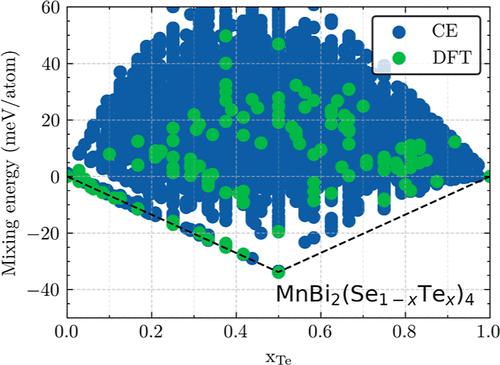利用精确扩散蒙特卡罗技术提高MnBi2(Se1-xTex)4的抗缺陷性和有序性
IF 3.2
3区 化学
Q2 CHEMISTRY, PHYSICAL
引用次数: 0
摘要
稳定材料和控制缺陷形成仍然是材料科学的关键挑战,特别是在理论中,为了准确预测,必须解决微小的能量差异。我们将最先进的理论方法应用于拓扑材料,重点研究了MnBi2Te4 (MBT),这是一种有前途的本禀磁性拓扑绝缘体。MBT中的反位缺陷改变了其电子结构和磁性,降低了其拓扑性能并导致实验不一致。利用扩散蒙特卡罗和密度泛函理论研究了MBT、MnBi2Se4 (MBS)和MnBi2(Se1-xTex)4的热力学稳定性和缺陷形成。我们发现MnBi2Se2Te2在有限温度下是稳定的,由于Mn-Se键的增强和内部应变的减小,MnBi2Se2Te2具有更高的缺陷形成能。Se优先取代Mn附近的Te,而不是外层的Te,当加入时鼓励长期有序。对于MnBi2(Se1-xTex)4,当x <;0.5时,簇展相图显示出固溶行为,当x较大时,簇展相图显示出相分离行为。因此,MnBi2(Se1-xTex)4家族可以提供可调的拓扑行为和提高的稳定性。本文章由计算机程序翻译,如有差异,请以英文原文为准。

Increased Defect Resistance and Ordering in MnBi2(Se1–xTex)4 via Accurate Diffusion Monte Carlo
Stabilizing materials and controlling defect formation remain key challenges in materials science, particularly for theory, where small energy differences must be resolved for accurate predictions. We applied state-of-the-art theoretical methods to topological materials, focusing on MnBi2Te4 (MBT), which is a promising intrinsic magnetic topological insulator. Antisite defects in MBT alter its electronic structure and magnetism, degrading topological properties and causing experimental inconsistencies. Using diffusion Monte Carlo and density functional theory, we investigated the thermodynamic stability and defect formation in MBT, MnBi2Se4 (MBS), and MnBi2(Se1–xTex)4. We found that MnBi2Se2Te2 can be stable at finite temperatures, with higher defect formation energies due to stronger Mn–Se bonding and reduced internal strain. Se preferentially substitutes Te near Mn instead of Te in the outer layer, encouraging long-range ordering when incorporated. For MnBi2(Se1–xTex)4, cluster expansion phase diagrams revealed solid solution behavior when x <0.5 and phase separation for larger x. MBT and MBS are topological insulators; therefore, the MnBi2(Se1–xTex)4 family could offer tunable topological behavior and improved stability.
求助全文
通过发布文献求助,成功后即可免费获取论文全文。
去求助
来源期刊

The Journal of Physical Chemistry C
化学-材料科学:综合
CiteScore
6.50
自引率
8.10%
发文量
2047
审稿时长
1.8 months
期刊介绍:
The Journal of Physical Chemistry A/B/C is devoted to reporting new and original experimental and theoretical basic research of interest to physical chemists, biophysical chemists, and chemical physicists.
 求助内容:
求助内容: 应助结果提醒方式:
应助结果提醒方式:


